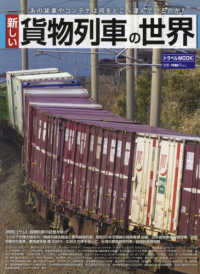- ホーム
- > 洋書
- > 英文書
- > Science / Mathematics
Full Description
When I encountered the idea of chaotic behavior in deterministic dynami cal systems, it gave me both great pause and great relief. The origin of the great relief was work I had done earlier on renormalization group properties of homogeneous, isotropic fluid turbulence. At the time I worked on that, it was customary to ascribe the apparently stochastic nature of turbulent flows to some kind of stochastic driving of the fluid at large scales. It was simply not imagined that with purely deterministic driving the fluid could be turbulent from its own chaotic motion. I recall a colleague remarking that there was something fundamentally unsettling about requiring a fluid to be driven stochastically to have even the semblance of complex motion in the velocity and pressure fields. I certainly agreed with him, but neither of us were able to provide any other reasonable suggestion for the observed, apparently stochastic motions of the turbulent fluid. So it was with relief that chaos in nonlinear systems, namely, complex evolution, indistinguish able from stochastic motions using standard tools such as Fourier analysis, appeared in my bag of physics notions. It enabled me to have a physi cally reasonable conceptual framework in which to expect deterministic, yet stochastic looking, motions. The great pause came from not knowing what to make of chaos in non linear systems.
Contents
1 Introduction.- 1.1 Chatter in Machine Tools.- 2 Reconstruction of Phase Space.- 2.1 Observations of Regular and Chaotic Motions.- 2.2 Chaos in Continuous and Discrete Time Dynamics.- 2.3 Observed Chaos.- 2.4 Embedding: Phase Space Reconstruction.- 2.5 Reconstruction Demystified.- 3 Choosing Time Delays.- 3.1 Prescriptions for a Time Delay.- 3.2 Chaos as an Information Source.- 3.3 Average Mutual Information.- 3.4 A Few Remarks About I(T).- 4 Choosing the Dimension of Reconstructed Phase Space.- 4.1 Global Embedding Dimension dE.- 4.2 Global False Nearest Neighbors.- 4.3 A Few Remarks About Global False Nearest Neighbors.- 4.4 False Strands.- 4.5 Other Methods for Identifying dE.- 4.6 The Local or Dynamical Dimension dL.- 4.7 Forward and Backward Lyapunov Exponents.- 4.8 Local False Neighbors.- 4.9 A Few Remarks About Local False Nearest Neighbors.- 5 Invariants of the Motion.- 5.1 Invariant Characteristics of the Dynamics.- 5.2 Fractal Dimensions.- 5.3 Global Lyapunov Exponents.- 5.4 Lyapunov Dimension.- 5.5 Global Lyapunov Exponents from Data.- 5.6 Local Lyapunov Exponents.- 5.7 Local Lyapunov Exponents from Data.- 5.8 A Few Remarks About Lyapunov Exponents.- 6 Modeling Chaos.- 6.1 Model Making in Chaos.- 6.2 Local Models.- 6.3 Global Models.- 6.4 Phase Space Models for Dependent Dynamical Variables.- 6.5 "Black Boxes" and Physics.- 7 Signal Separation.- 7.1 General Comments.- 7.2 Full Knowledge of the Dynamics.- 7.3 Knowing a Signal: Probabilistic Cleaning.- 7.4 "Blind" Signal Separation.- 7.5 A Few Remarks About Signal Separation.- 8 Control and Chaos.- 8.1 Parametric Control to Unstable Periodic Orbits.- 8.2 Other Controls.- 8.3 Examples of Control.- 8.4 A Few (Irreverent) Remarks About Chaos and Control.- 9 Synchronization of Chaotic Systems.- 9.1Identical Systems.- 9.2 Dissimilar Systems.- 9.3 Mutual False Nearest Neighbors.- 9.4 Predictability Tests for Generalized Synchronization.- 9.5 A Few Remarks About Synchronization.- 10 Other Example Systems.- 10.1 Chaotic Laser Intensity Fluctuations.- 10.2 Chaotic Volume Fluctuations of the Great Salt Lake.- 10.3 Chaotic Motion in a Fluid Boundary Layer.- 11 Estimating in Chaos: Cramér-Rao Bounds.- 11.1 The State Estimation Problem.- 11.2 The Cramér-Rao Bound.- 11.3 Symmetric Linear Dynamics.- 11.4 Arbitrary, Time-Invariant, Linear Systems.- 11.5 Nonlinear, Chaotic Dynamics.- 11.6 Connection with Chaotic Signal Separation.- 11.7 Conclusions.- 12 Summary and Conclusions.- 12.1 The Toolkit-Present and Future.- 12.2 Making 'Physics' out of Chaos-Present and Future.- 12.3 Topics for the Next Edition.- A.1 Information Theory and Nonlinear Systems.- A.2 Stability and Instability.- A.2.1 Lorenz Model.- References.




